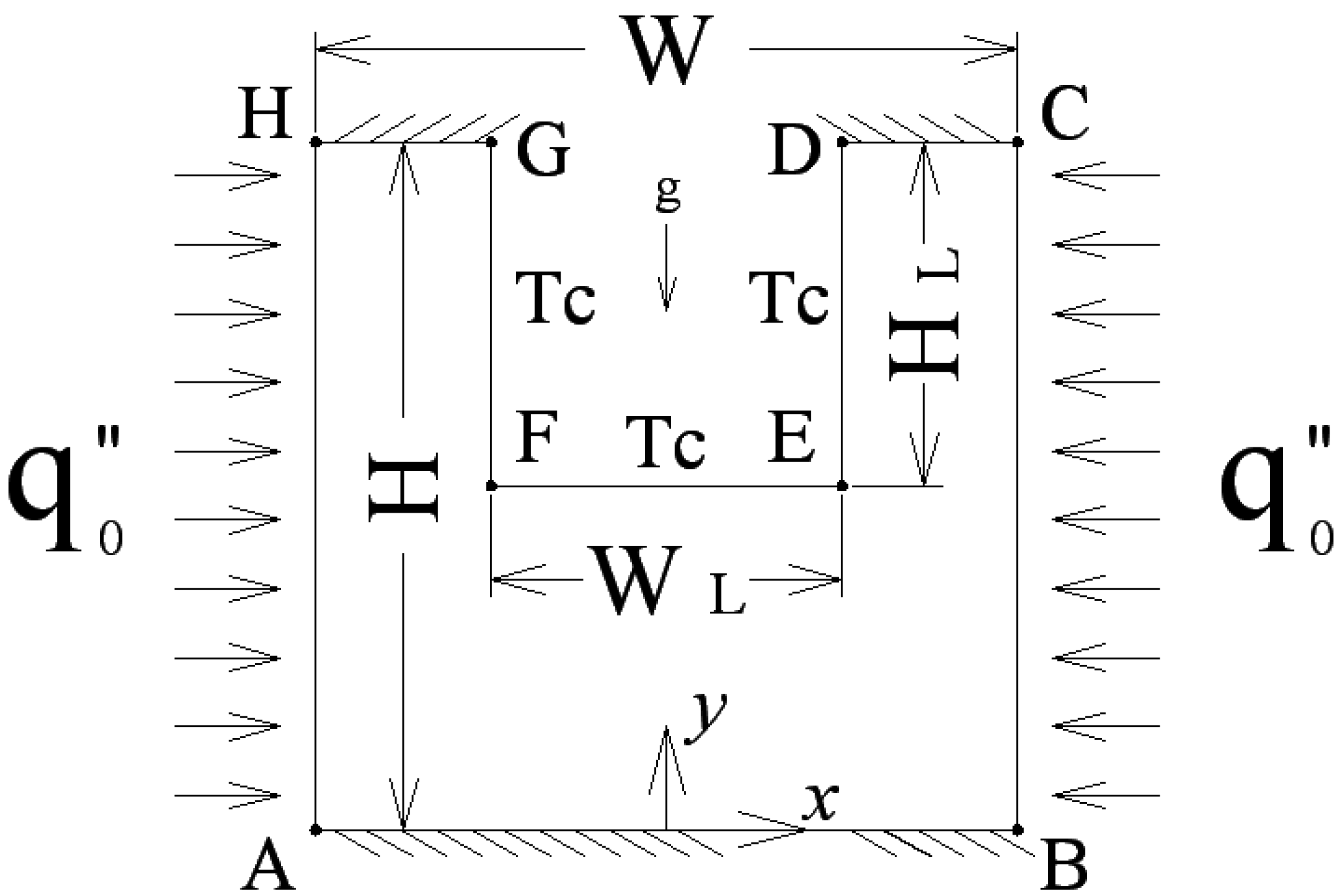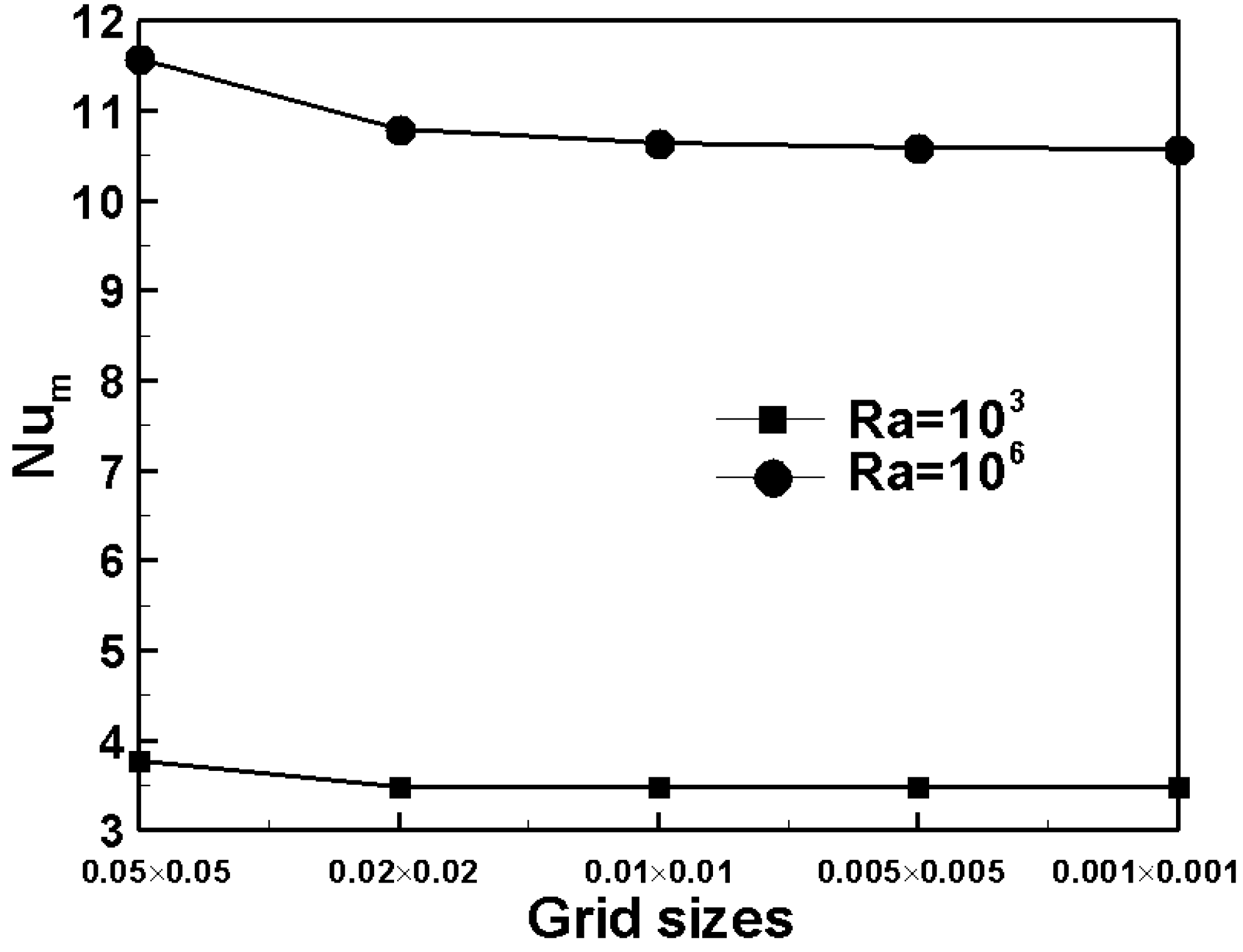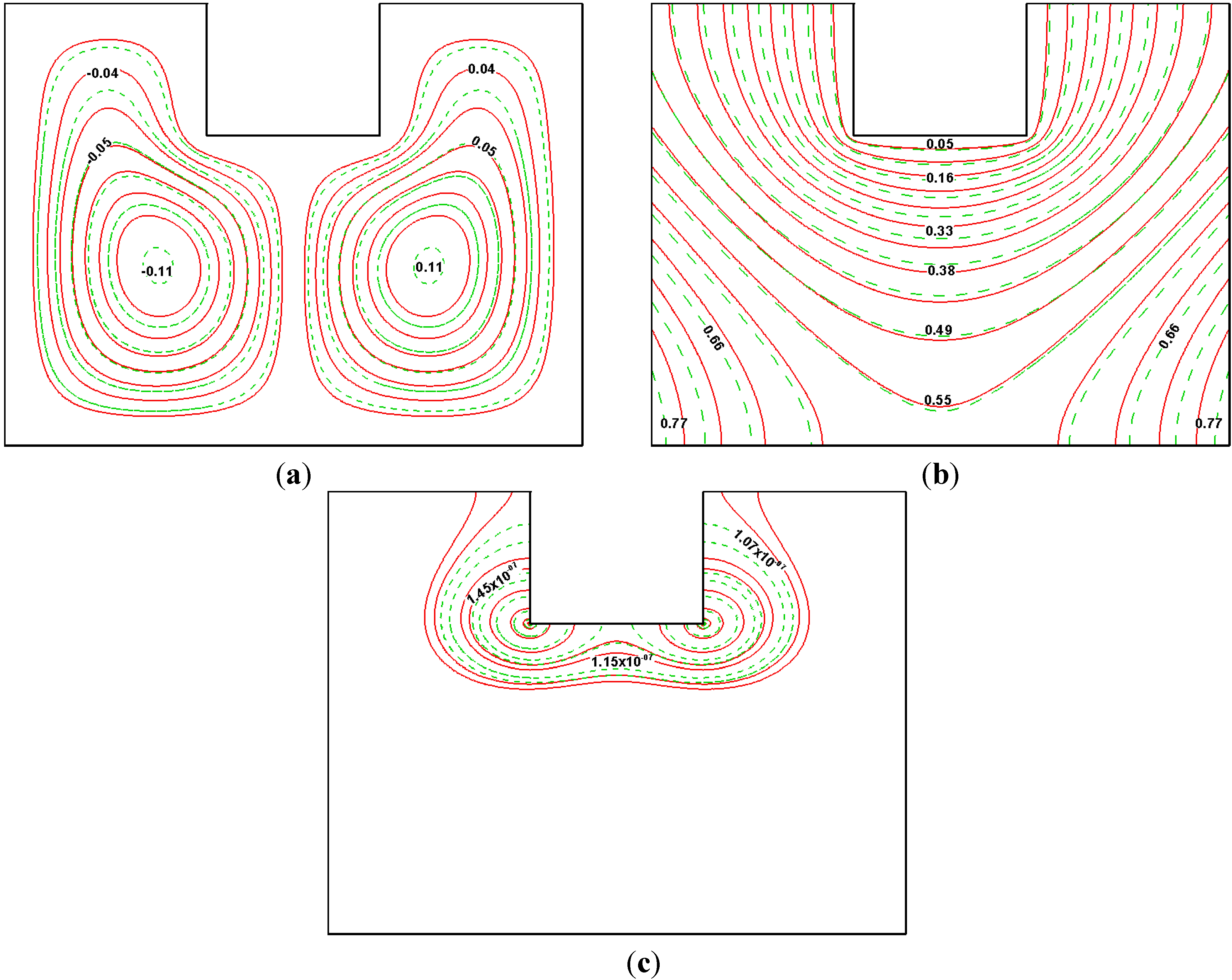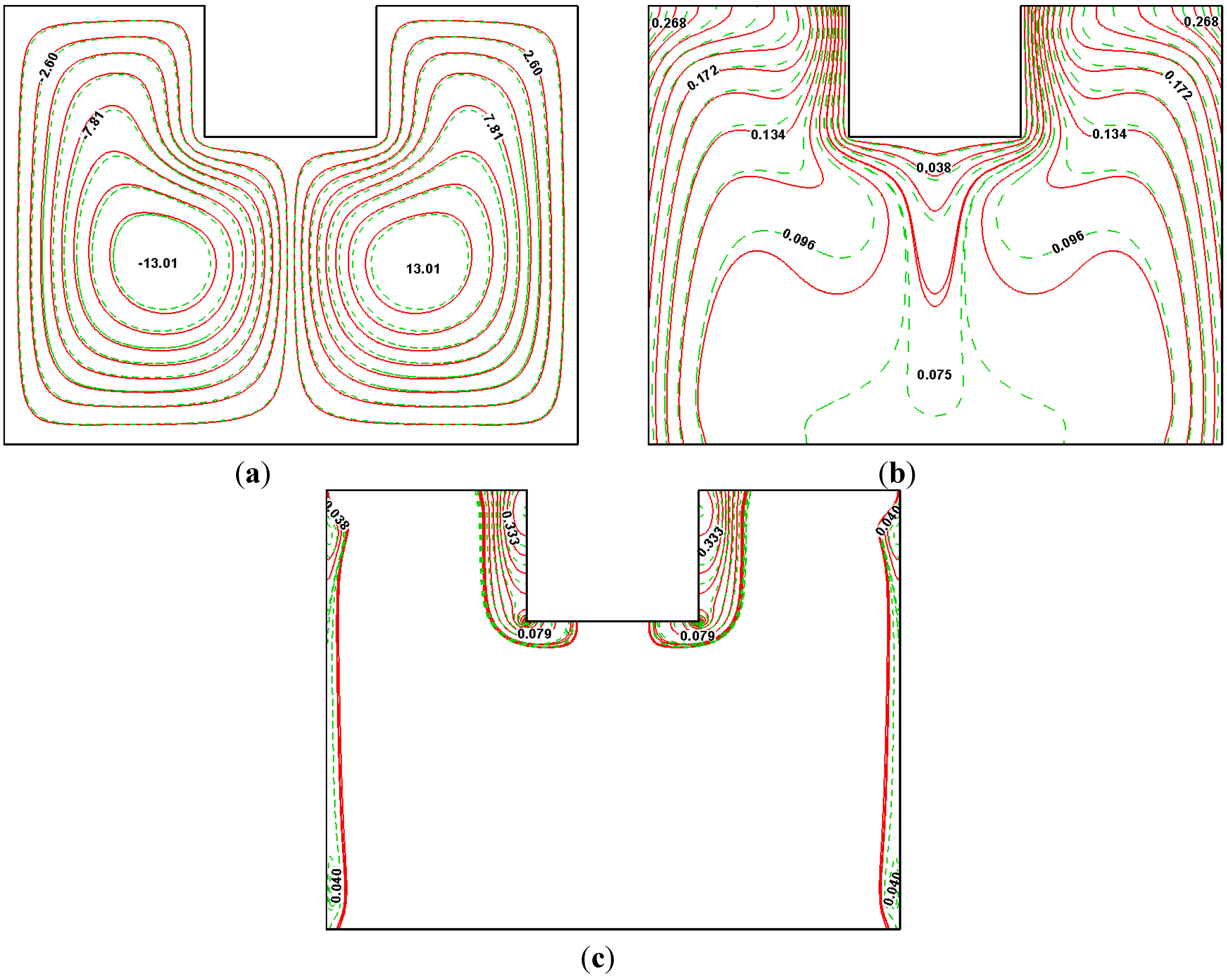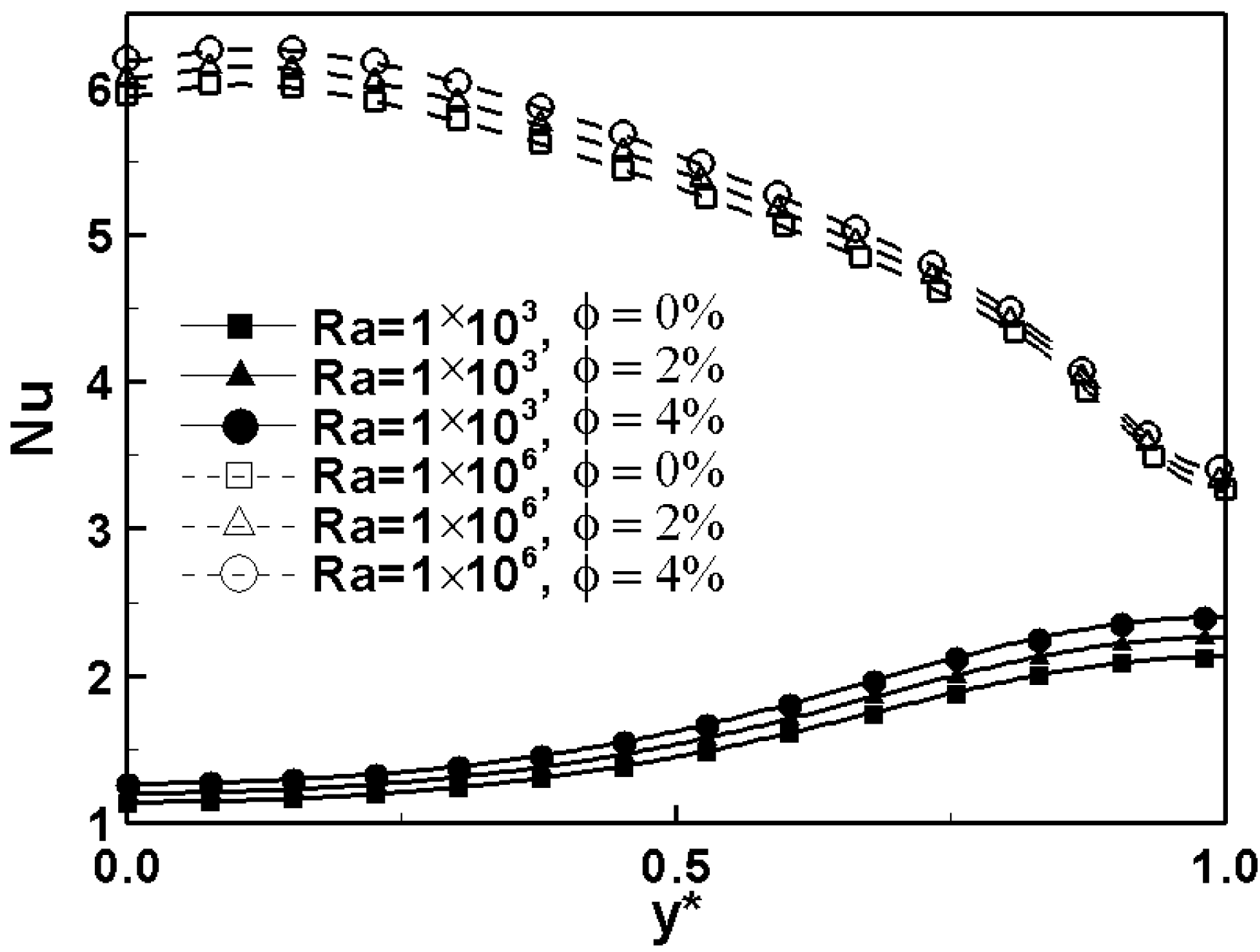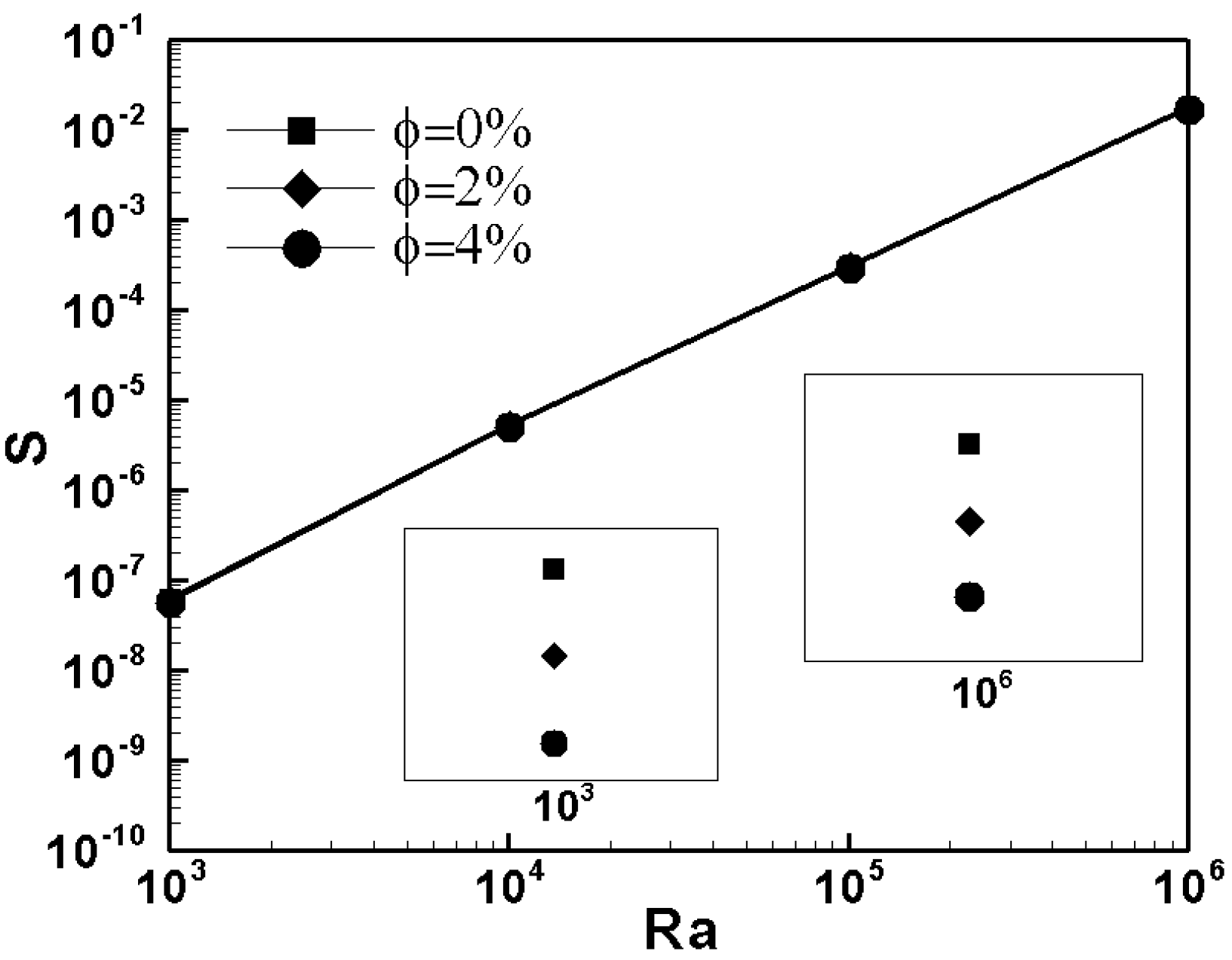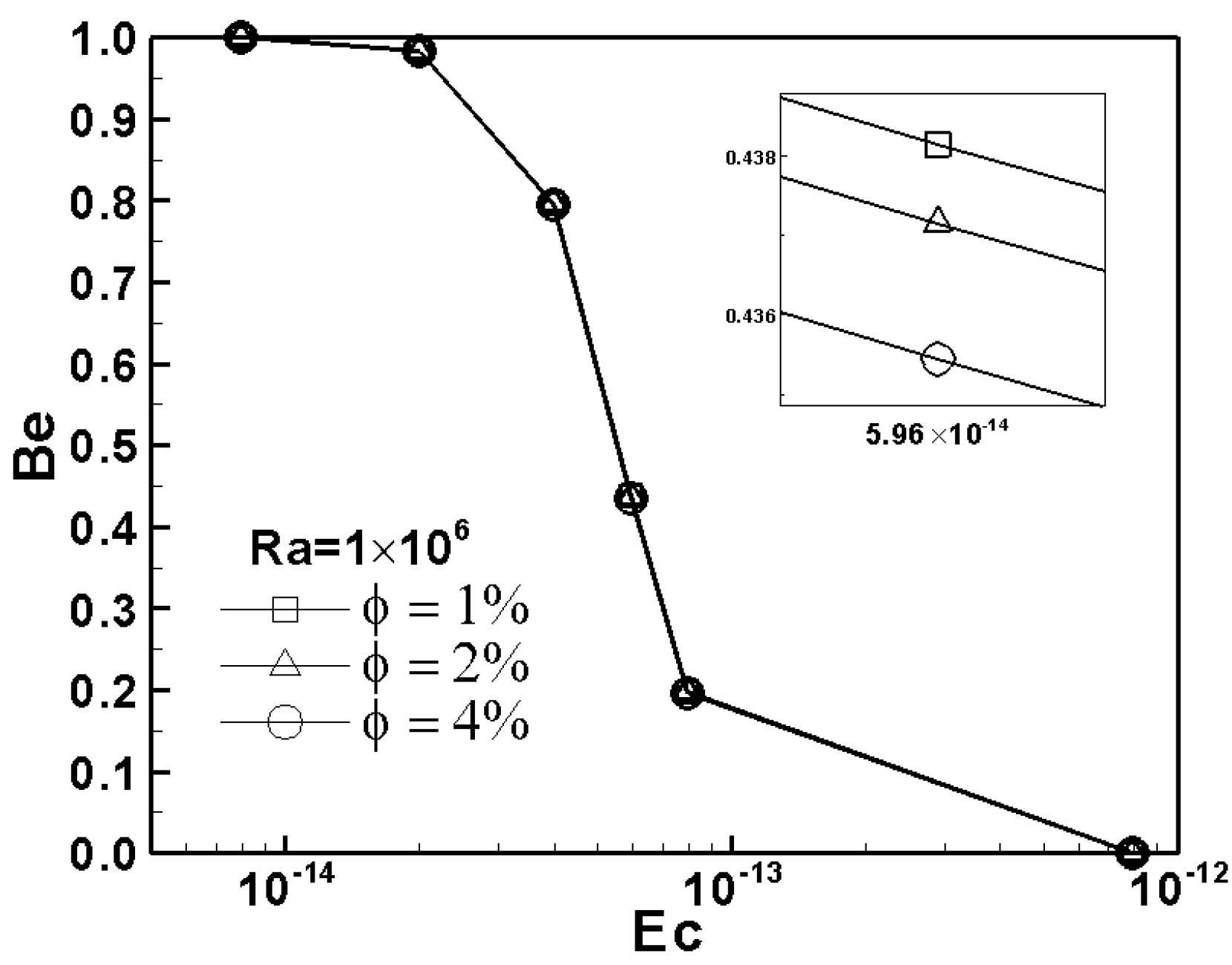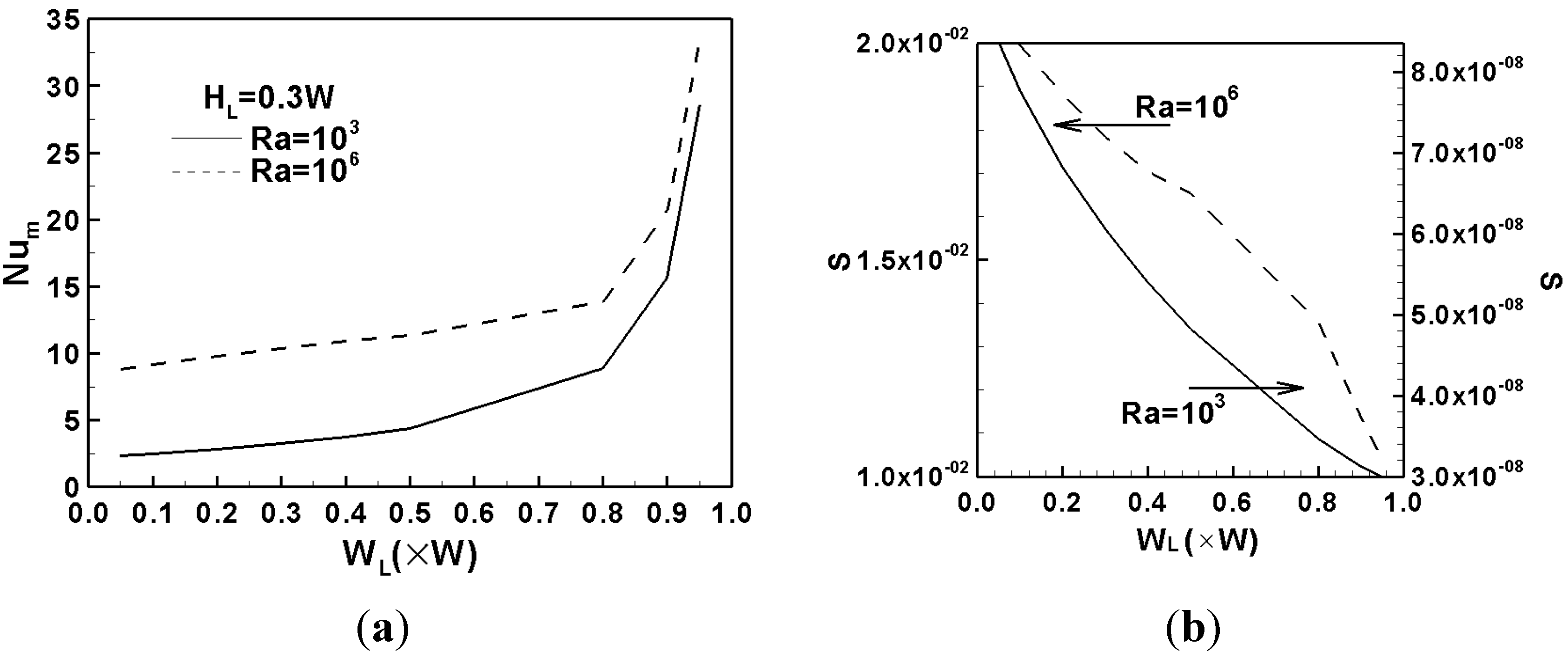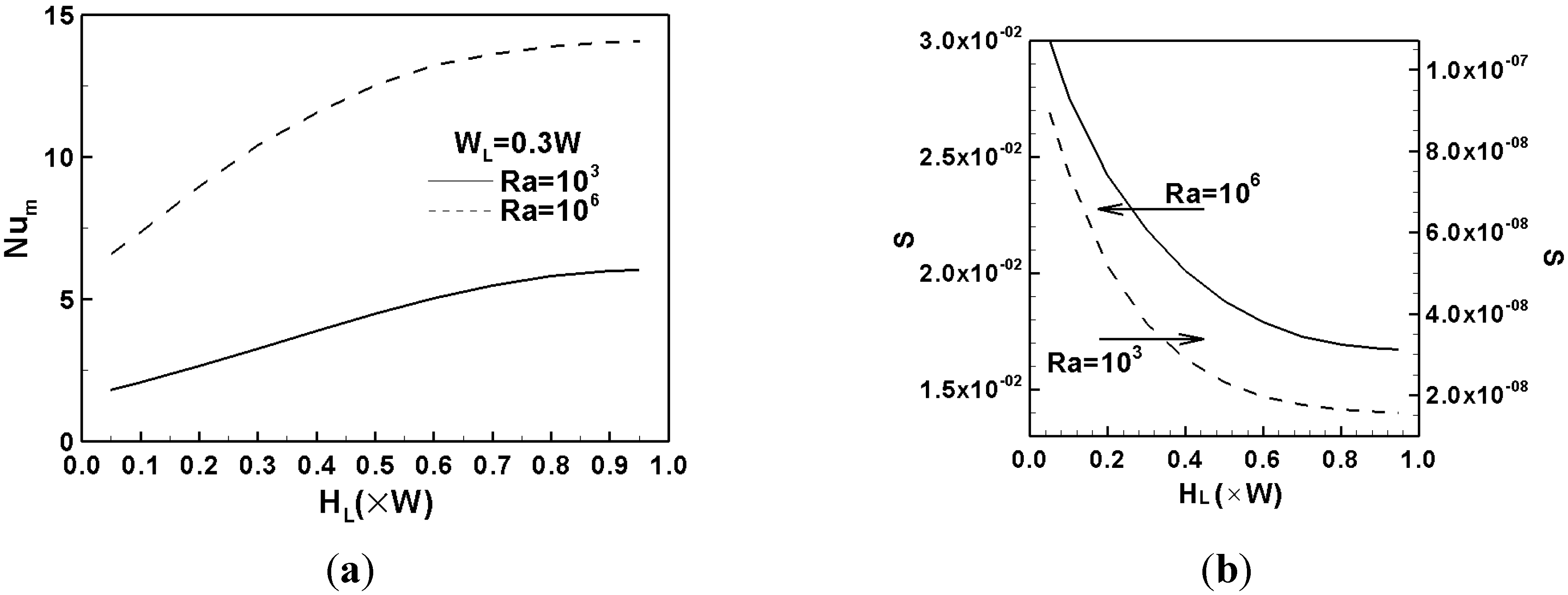1. Introduction
During all fluid flow and heat transfer processes, useful energy will be lost due to the generation of irreversibilities. Generally, the magnitude of these irreversibilities can be estimated by the rate of the entropy generation. Therefore, in a system, it is necessary to minimize the rate of the entropy generation so that the useful energy can be maximized [
1,
2].
Natural convection in cavities is of great practical interest in many engineering applications, including electronic cooling devices, heat exchangers, electric machinery, solar energy collectors, and so on [
3]. To optimize the useful energy in such applications, many researchers have studied the entropy generation of natural convection in cavities. For example, Erbay
et al. [
4,
5] and Magherbi
et al. [
6] studied the transient entropy generation of natural convection in square cavities with completely- or partially-heated left-side walls, respectively, and a completely cooled right-side wall. They have considered the effects of heat transfer irreversibility and fluid friction irreversibility on the entropy generation and had analyzed the transient behavior of the entropy generation in the studied cavity. Bounabid
et al. [
7] analyzed the transient entropy generation of natural convection in an inclined rectangular cavity comprising vertical isothermal walls and adiabatic horizontal walls. Their results have shown that the entropy generation increased with the increases of Grashof number, irreversibility distribution ratio and aspect ratio of the cavity. Ilis
et al. [
8] investigated the entropy generation caused by natural convection in a rectangular cavity with a high-temperature left-side wall and a low-temperature right-side wall. Their results have indicated that depending on the Rayleigh number and irreversibility distribution ratio, the total entropy generation of the cavity was dominated by the heat transfer irreversibility or by the fluid friction irreversibility. Mukhopadhyay [
9] examined the entropy generation induced by natural convection in a square cavity heated by two isoflux sources. Their results have shown that the entropy generation can be optimized by turning the length and position of the heat sources. Dagtekin
et al. [
10] analyzed the entropy generation of natural convection in a Γ-shaped cavity with a heated step. Their results showed that at low Rayleigh numbers, the effect of the aspect ratio on the entropy generation in the studied cavity was not significant and the entropy generation was dominated mainly by the heat transfer irreversibility. However, at high Rayleigh numbers, the effect of the aspect ratio on the entropy generation was significant and the effect of the fluid friction irreversibility on the entropy generation becomes more effective.
Nanofluids consist of nanoparticles with high thermal conductivity suspended in a base fluid with low thermal conductivity [
11]. As a result, nanofluids provide excellent thermophysical properties than conventional working fluids. Recently, many researchers have studied the entropy generation of natural convection in nanofluid-filled cavities. For example, Shahi
et al. [
12] studied the entropy generation of natural convection in a nanofluid-filled square cavity heated by a protruding heat source. Their results have shown that the entropy generation reduced as the nanoparticle volume fraction was increased. In addition, their results have also shown that the entropy generation could be minimized when the heat source was positioned on the lower wall of the cavity. Kefayati [
13] presented a numerical investigation into the entropy generation due to natural convection in a non-Newtonian nanofluid-filled cavity bounded by two isothermal vertical walls and two adiabatic horizontal walls. Their results showed that the Bejan number reduced as the Rayleigh number increased. In addition, their results also showed that the addition of nanoparticles caused a decrease in the Bejan number. Parvin and Chamkha [
14] examined the entropy generation of natural convection in an odd-shaped cavity filled with Cu–water nanofluid. The results showed that in the odd-shaped cavity, the entropy generation could be minimized by giving a particular Rayleigh number. Cho
et al. [
15] investigated the entropy generation induced by natural convection in a water-based nanofluid-filled cavity bounded by a left wavy-wall with a constant heat flux, a right wavy-wall with a constant low temperature, and flat upper and lower walls with adiabatic conditions. Their results showed that the entropy generation could by minimized via an appropriate tuning of the wavy surface geometry parameters. Cho [
16] also investigated the entropy generation in a partially-heated wavy-wall square cavity filled with Al
2O
3-water nanofluid. The results have shown that in the studied cavity, the total entropy generation increased as the amplitude and wavelength of the wavy-surface increased. In addition, the results have also shown that given a suitable location of the partially-heated wavy surface in the cavity, the entropy generation could be reduced.
The natural convection heat transfer performance in a U-shaped cavity has been investigated [
17]. However, the study of the entropy generation in a U-shaped cavity caused by natural convection is not presented in the literature. Therefore, the present work investigates the heat transfer performance and entropy generation of natural convection in a U-shaped cavity filled with Al
2O
3-water nanofluid. In performing the study, the flow behavior and heat transfer characteristics in the cavity are governed by the continuity equation, momentum equations, energy equation and Boussinesq approximation. Finite-volume method and SIMPLE C (semi-implicit method for pressure-linked equations consistent) algorithm are used to solve the governing equations numerically. The simulations focus specifically on the effects of the nanoparticle volume fraction, Rayleigh number, and geometry parameters of the U-shaped cavity on the mean Nusselt number and total entropy generation.
3. Results and Discussion
In this study, Al
2O
3-water nanofluid is used to be the medium of thermal transportation. The thermophysical properties of the Al
2O
3 nanoparticles are given as follows [
18]: specific heat,
; density,
; thermal conductivity,
; and thermal expansion coefficient,
. In addition, the thermophysical properties of the water are specified as follows: specific heat,
; density,
; thermal conductivity,
; and thermal expansion coefficient,
. In addition, the Prandtl number is given as
. Finally, it is assumed that the width of the cavity is equal to the height of the cavity,
i.e.,
.
Prior to the simulations, a grid-independence analysis was performed to determine the mesh size.
Figure 2 plots the variation of the mean Nusselt number with the grid size. It is seen that a grid size of
ensures a grid-independent solution. The computational domain was thus meshed accordingly.
Figure 2.
Variation of mean Nusselt number with grid mesh size. Note that , and .
Figure 2.
Variation of mean Nusselt number with grid mesh size. Note that , and .
Figure 3a–c show the flow streamlines, isotherms and entropy generation, respectively, within the U-shaped cavity for a Rayleigh number of
and different nanoparticle volume fractions.
Figure 4a–c present the equivalent results for a Rayleigh number of
. Since the U-shaped cavity is heated by the left and right walls and is cooled by the concave walls of the U-shaped cavity, the fluid rises from the left and right walls and then falls along the concave walls of the U-shaped cavity. As a result, two flow circulation structures with opposite rotating direction are presented in the cavity (see
Figure 3a and
Figure 4a). Given a low Rayleigh number, since the thermally-induced buoyancy effect is weak, the conduction mechanism dominates the heat transfer effect. Therefore, the strength of the flow streamlines is low (see
Figure 3a) and the isotherms have no significantly twisting occurrence (see
Figure 3b). Given a high Rayleigh number, since the thermally-induced buoyancy effect is strong, the convection mechanism dominates the heat transfer effect. As a result, the strength of the flow streamlines is high (see
Figure 4a) and thus a significant twisting of the isotherms occurs (see
Figure 4b). It is observed that the isotherms are concentrated near the heated and cooled walls. These regions experience a high temperature gradient, resulting in the formation of active regions for local entropy generation (see
Figure 3c and
Figure 4c).
Figure 3.
(a) Flow streamlines, (b) isotherms and (c) entropy generation given a Rayleigh number of . Note that solid line represents the pure water and dashed line represents nanofluid fluid with . Note also that , and .
Figure 3.
(a) Flow streamlines, (b) isotherms and (c) entropy generation given a Rayleigh number of . Note that solid line represents the pure water and dashed line represents nanofluid fluid with . Note also that , and .
Figure 4.
(a) Flow streamlines, (b) isotherms and (c) entropy generation given a Rayleigh number of . Note that solid line represents the pure water and dashed line represents nanofluid fluid with . Note also that , and .
Figure 4.
(a) Flow streamlines, (b) isotherms and (c) entropy generation given a Rayleigh number of . Note that solid line represents the pure water and dashed line represents nanofluid fluid with . Note also that , and .
In addition, the addition of nanoparticles to the base fluid increases the thermal conductivity and viscosity of the working fluid. The increase of the viscosity decreases the fluid velocity. As a result, the strength of the streamlines is lower in the nanofluid than in pure water (see
Figure 3a and
Figure 4a). The increase of the thermal conductivity in the nanofluid enhances the heat energy transport, leading to an improved heat transfer performance (see
Figure 3b and
Figure 4b). Furthermore, since the Bejan number approaches unity for the two cases of
Figure 3 and
Figure 4, the effect of the fluid friction irreversibility on the total entropy generation could be neglected. In other words, the heat transfer irreversibility dominates the total entropy generation. Since the addition of nanoparticles can increase the heat energy transport of the working fluid, the heat transfer irreversibility can be decreased. Consequently, the total entropy generation in nanofluid is lower than in pure fluid (see
Figure 3c and
Figure 4c).
Figure 5 plots the variation of the local Nusselt number along the left heated wall for various nanoparticle volume fractions and Rayleigh numbers.
Figure 6 shows the variations of the mean Nusselt number with the Rayleigh number as a function of the nanoparticle volume fraction. Given a low Rayleigh number, since the conduction mechanism dominates the heat transfer effect due to weak buoyancy effect, the local Nusselt number is low. Consequently, a low mean Nusselt number is obtained. However, given a high Rayleigh number, the convection mechanism dominates the heat transfer and thus the fluid in the cavity is perturbed strongly by the convection mechanism. As a result, the local Nusselt number has a higher value and thus a higher mean Nusselt number is presented. In addition, since the addition of nanoparticles to the base fluid increases the thermal conductivity of the working fluid, the heat energy can be transported faster. As a result, nanofluid has a higher mean Nusselt number.
Figure 5.
Variation of local Nusselt number along left heated wall for different nanoparticle volume fractions and Rayleigh numbers. Note that and .
Figure 5.
Variation of local Nusselt number along left heated wall for different nanoparticle volume fractions and Rayleigh numbers. Note that and .
Figure 6.
Variation of mean Nusselt number with Rayleigh number as function of nanoparticle volume fraction. Note that and .
Figure 6.
Variation of mean Nusselt number with Rayleigh number as function of nanoparticle volume fraction. Note that and .
Figure 7 plots the variation of the total entropy generation with the Rayleigh number as a function of the nanoparticle volume fraction. Since the conduction mechanism dominates the heat transfer performance under the condition of a low Rayleigh number, the strength of the fluid flow is low and a low temperature gradient is presented. Therefore, the local entropy generations due to the fluid friction irreversibility and due to the heat transfer irreversibility are both low. Consequently, a low total entropy generation is obtained. However, given a high Rayleigh number, the heat transfer effect is dominated by the convection effect. Therefore, the strength of the fluid flow is high and a high temperature gradient is presented. As a result, the effects of fluid friction irreversibility and heat transfer irreversibility on the local entropy generation are increased. Consequently, the total entropy generation is higher. In addition, since the heat energy can be transported faster in nanofluid than in pure water, nanofluid has a lower total entropy generation.
Figure 7.
Variation of total entropy generation with Rayleigh number as function of nanoparticle volume fraction. Note that , , and .
Figure 7.
Variation of total entropy generation with Rayleigh number as function of nanoparticle volume fraction. Note that , , and .
Figure 8 plots the variation of the Bejan number with the Eckert number as a function of the nanoparticle volume fraction. Generally, the magnitude of the viscous dissipation is determined by the Eckert number. Given the small value of the Eckert number, a low viscous dissipation is presented, resulting in a low fluid friction irreversibility. As a result, the effect of the fluid friction irreversibility on the total entropy generation can be ignored. Consequently, the heat transfer irreversibility dominates the total entropy generation, and thus the Bejan number approaches unity. As the Eckert number increases, the effect of the fluid friction irreversibility on the total entropy generation is increased. As a result, the Bejan number decreases. In addition, the thermal conductivity and viscosity of the working fluid both increases as the volume fraction of nanoparticle is increased. The two thermophysical properties have competing effects on the total entropy generation within the cavity. Since a low volume fraction of nanoparticle is added, the variation of the Bejan number is slight.
Figure 8.
Variation of Bejan number with Eckert number as function of nanoparticle volume fraction given a Rayleigh number of . Note that and .
Figure 8.
Variation of Bejan number with Eckert number as function of nanoparticle volume fraction given a Rayleigh number of . Note that and .
Figure 9a,b show the variation of the mean Nusselt number and total entropy generation, respectively, with the geometry parameter
as a function of the Rayleigh number. As
increases, the distance between the low temperature walls and the heated walls shortens. As a result, the heat can be transported quickly from the heated walls to the low temperature walls. Therefore, in the range of
, the mean Nusselt number increases as the width of
is increased. In addition, since the heat can be transported faster at a larger
, a low temperature gradient is presented in the cavity. Therefore, in the range of
, the total entropy generation decreases as the width of
is increased.
Figure 9.
(a) Variation of mean Nusselt number with geometry parameter as function of Rayleigh number, and (b) variation of total entropy generation with geometry parameter as function of Rayleigh number. Note that , , , and .
Figure 9.
(a) Variation of mean Nusselt number with geometry parameter as function of Rayleigh number, and (b) variation of total entropy generation with geometry parameter as function of Rayleigh number. Note that , , , and .
Figure 10a,b shows the variation of the mean Nusselt number and total entropy generation, respectively, with the geometry parameter
as a function of the Rayleigh number. As
increases, the length of the low temperature walls lengthens. A larger heat transfer area is presented in the cavity, and thus the heat can be removed quickly. As a result, a higher mean Nusselt number and a lower total entropy generation are obtained.
Figure 10.
(a) Variation of mean Nusselt number with geometry parameter as function of Rayleigh number, and (b) variation of total entropy generation with geometry parameter as function of Rayleigh number. Note that , , , and .
Figure 10.
(a) Variation of mean Nusselt number with geometry parameter as function of Rayleigh number, and (b) variation of total entropy generation with geometry parameter as function of Rayleigh number. Note that , , , and .
Overall, the results presented in the study show that the mean Nusselt number can be increased and the total entropy generation can be reduced by widening the width of extending the length of , or increasing the volume fraction of nanoparticles. These results provide a useful source of reference for enhancing the heat transfer effect while simultaneously reducing the entropy generation.
